automatic transmission OPEL CORSA F 2020 Owner's Guide
[x] Cancel search | Manufacturer: OPEL, Model Year: 2020, Model line: CORSA F, Model: OPEL CORSA F 2020Pages: 229, PDF Size: 21.14 MB
Page 135 of 229
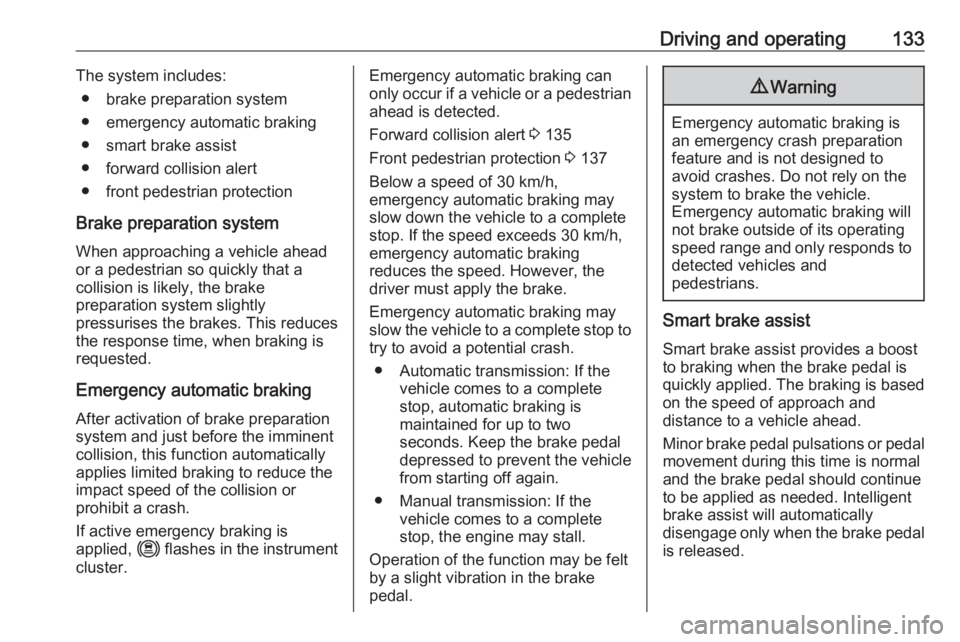
Driving and operating133The system includes:● brake preparation system
● emergency automatic braking
● smart brake assist
● forward collision alert
● front pedestrian protection
Brake preparation system
When approaching a vehicle ahead
or a pedestrian so quickly that a
collision is likely, the brake
preparation system slightly
pressurises the brakes. This reduces
the response time, when braking is
requested.
Emergency automatic braking
After activation of brake preparation
system and just before the imminent
collision, this function automatically
applies limited braking to reduce the
impact speed of the collision or
prohibit a crash.
If active emergency braking is
applied, m flashes in the instrument
cluster.Emergency automatic braking can
only occur if a vehicle or a pedestrian ahead is detected.
Forward collision alert 3 135
Front pedestrian protection 3 137
Below a speed of 30 km/h,
emergency automatic braking may
slow down the vehicle to a complete
stop. If the speed exceeds 30 km/h,
emergency automatic braking
reduces the speed. However, the
driver must apply the brake.
Emergency automatic braking may slow the vehicle to a complete stop to
try to avoid a potential crash.
● Automatic transmission: If the vehicle comes to a complete
stop, automatic braking is
maintained for up to two
seconds. Keep the brake pedal
depressed to prevent the vehicle
from starting off again.
● Manual transmission: If the vehicle comes to a complete
stop, the engine may stall.
Operation of the function may be felt
by a slight vibration in the brake
pedal.9 Warning
Emergency automatic braking is
an emergency crash preparation
feature and is not designed to
avoid crashes. Do not rely on the
system to brake the vehicle.
Emergency automatic braking will
not brake outside of its operating speed range and only responds to
detected vehicles and
pedestrians.
Smart brake assist
Smart brake assist provides a boost
to braking when the brake pedal is quickly applied. The braking is based on the speed of approach and
distance to a vehicle ahead.
Minor brake pedal pulsations or pedal
movement during this time is normal
and the brake pedal should continue to be applied as needed. Intelligent
brake assist will automatically
disengage only when the brake pedal is released.
Page 142 of 229
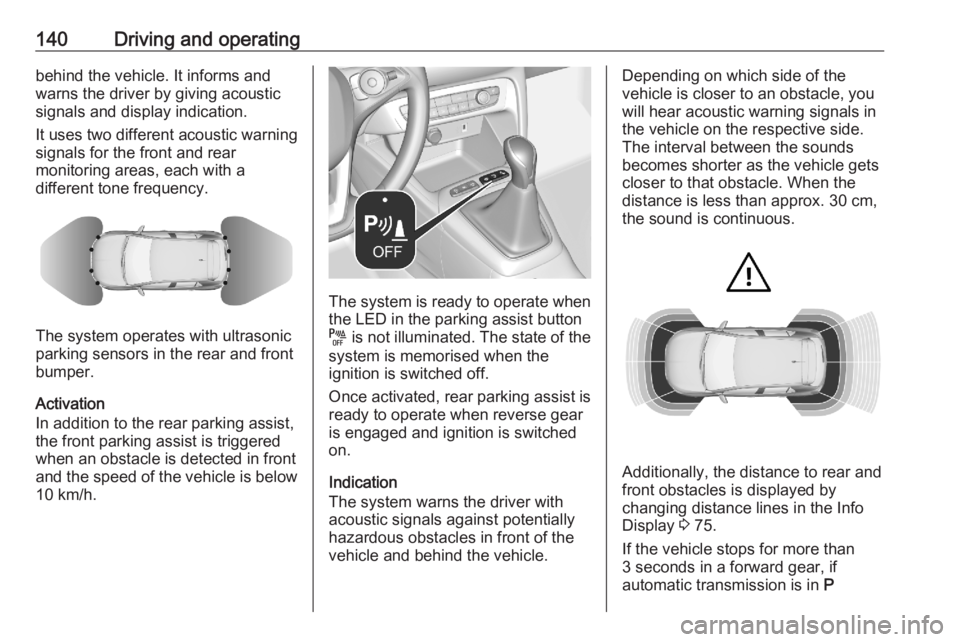
140Driving and operatingbehind the vehicle. It informs and
warns the driver by giving acoustic
signals and display indication.
It uses two different acoustic warning
signals for the front and rear
monitoring areas, each with a
different tone frequency.
The system operates with ultrasonic
parking sensors in the rear and front
bumper.
Activation
In addition to the rear parking assist,
the front parking assist is triggered
when an obstacle is detected in front
and the speed of the vehicle is below 10 km/h.
The system is ready to operate when
the LED in the parking assist button
e is not illuminated. The state of the
system is memorised when the
ignition is switched off.
Once activated, rear parking assist is
ready to operate when reverse gear
is engaged and ignition is switched
on.
Indication
The system warns the driver with acoustic signals against potentially
hazardous obstacles in front of the
vehicle and behind the vehicle.
Depending on which side of the
vehicle is closer to an obstacle, you
will hear acoustic warning signals in the vehicle on the respective side.
The interval between the sounds
becomes shorter as the vehicle gets
closer to that obstacle. When the
distance is less than approx. 30 cm,
the sound is continuous.
Additionally, the distance to rear and
front obstacles is displayed by
changing distance lines in the Info Display 3 75.
If the vehicle stops for more than
3 seconds in a forward gear, if
automatic transmission is in P
Page 177 of 229
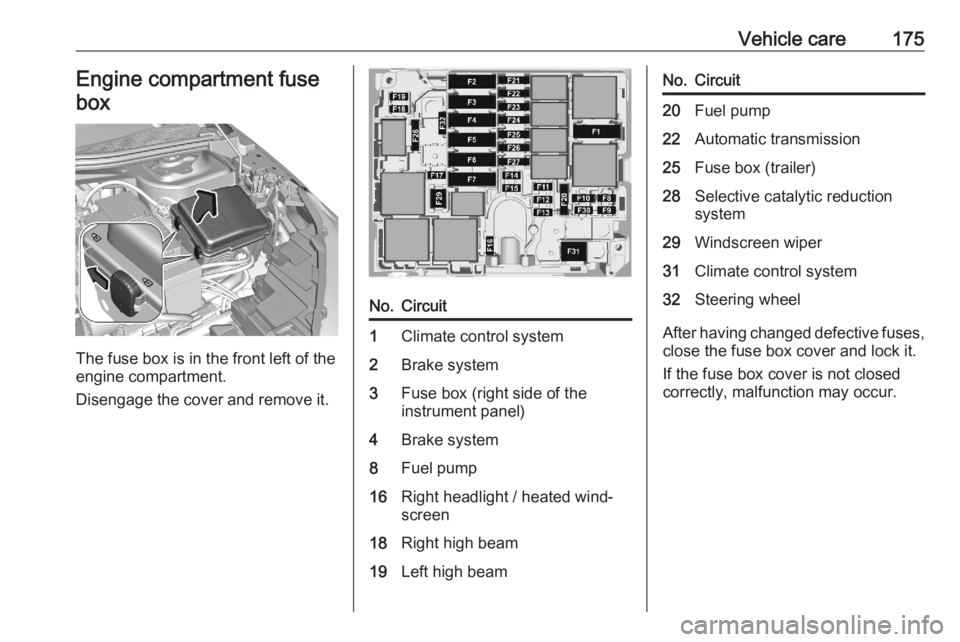
Vehicle care175Engine compartment fusebox
The fuse box is in the front left of the
engine compartment.
Disengage the cover and remove it.
No.Circuit1Climate control system2Brake system3Fuse box (right side of the
instrument panel)4Brake system8Fuel pump16Right headlight / heated wind‐
screen18Right high beam19Left high beamNo.Circuit20Fuel pump22Automatic transmission25Fuse box (trailer)28Selective catalytic reduction
system29Windscreen wiper31Climate control system32Steering wheel
After having changed defective fuses,
close the fuse box cover and lock it.
If the fuse box cover is not closed
correctly, malfunction may occur.
Page 193 of 229
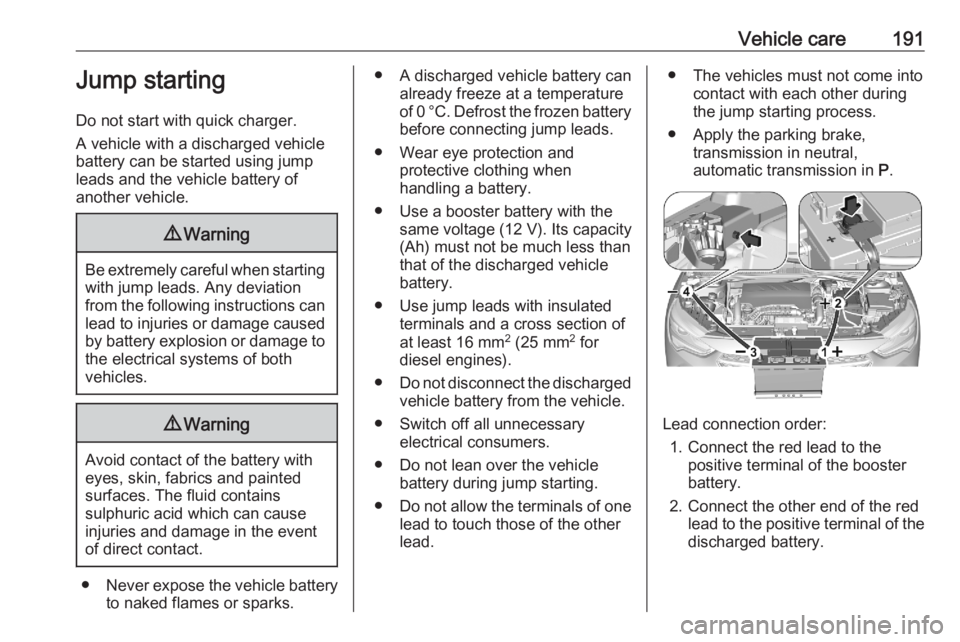
Vehicle care191Jump starting
Do not start with quick charger.
A vehicle with a discharged vehicle
battery can be started using jump
leads and the vehicle battery of
another vehicle.9 Warning
Be extremely careful when starting
with jump leads. Any deviation
from the following instructions can
lead to injuries or damage caused
by battery explosion or damage to the electrical systems of both
vehicles.
9 Warning
Avoid contact of the battery with
eyes, skin, fabrics and painted
surfaces. The fluid contains
sulphuric acid which can cause
injuries and damage in the event
of direct contact.
● Never expose the vehicle battery
to naked flames or sparks.
● A discharged vehicle battery can already freeze at a temperature
of 0 °C. Defrost the frozen battery before connecting jump leads.
● Wear eye protection and protective clothing when
handling a battery.
● Use a booster battery with the same voltage (12 V). Its capacity
(Ah) must not be much less than
that of the discharged vehicle battery.
● Use jump leads with insulated terminals and a cross section of
at least 16 mm 2
(25 mm 2
for
diesel engines).
● Do not disconnect the discharged
vehicle battery from the vehicle.
● Switch off all unnecessary electrical consumers.
● Do not lean over the vehicle battery during jump starting.
● Do not allow the terminals of one
lead to touch those of the other
lead.● The vehicles must not come into contact with each other during
the jump starting process.
● Apply the parking brake, transmission in neutral,
automatic transmission in P.
Lead connection order:
1. Connect the red lead to the positive terminal of the booster
battery.
2. Connect the other end of the red lead to the positive terminal of the
discharged battery.
Page 195 of 229
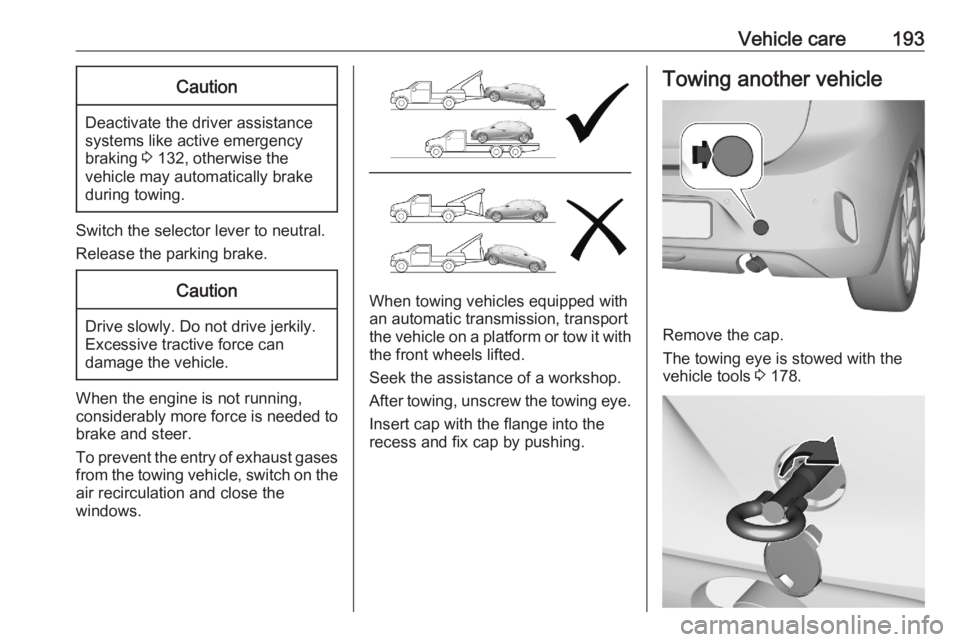
Vehicle care193Caution
Deactivate the driver assistance
systems like active emergency
braking 3 132, otherwise the
vehicle may automatically brake during towing.
Switch the selector lever to neutral.
Release the parking brake.
Caution
Drive slowly. Do not drive jerkily.
Excessive tractive force can
damage the vehicle.
When the engine is not running,
considerably more force is needed to
brake and steer.
To prevent the entry of exhaust gases from the towing vehicle, switch on the
air recirculation and close the
windows.
When towing vehicles equipped with
an automatic transmission, transport
the vehicle on a platform or tow it with
the front wheels lifted.
Seek the assistance of a workshop.
After towing, unscrew the towing eye.
Insert cap with the flange into the
recess and fix cap by pushing.
Towing another vehicle
Remove the cap.
The towing eye is stowed with the
vehicle tools 3 178.
Page 210 of 229
![OPEL CORSA F 2020 Owners Guide 208Technical dataPerformanceEngineEB2FAEB2ADTDEB2ADTSDV5RDMaximum speed [km/h]Manual transmission174188–188Automatic transmission–188208– OPEL CORSA F 2020 Owners Guide 208Technical dataPerformanceEngineEB2FAEB2ADTDEB2ADTSDV5RDMaximum speed [km/h]Manual transmission174188–188Automatic transmission–188208–](/img/37/18833/w960_18833-209.png)
208Technical dataPerformanceEngineEB2FAEB2ADTDEB2ADTSDV5RDMaximum speed [km/h]Manual transmission174188–188Automatic transmission–188208–
Page 224 of 229
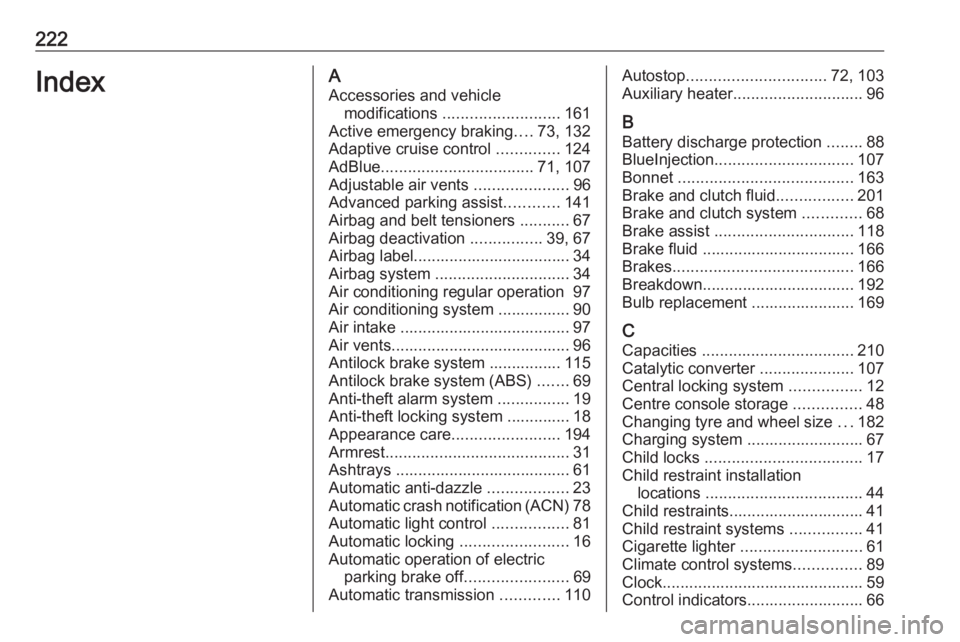
222IndexAAccessories and vehicle modifications .......................... 161
Active emergency braking ....73, 132
Adaptive cruise control ..............124
AdBlue .................................. 71, 107
Adjustable air vents .....................96
Advanced parking assist ............141
Airbag and belt tensioners ...........67
Airbag deactivation ................39, 67
Airbag label................................... 34 Airbag system .............................. 34
Air conditioning regular operation 97
Air conditioning system ................ 90
Air intake ...................................... 97
Air vents........................................ 96
Antilock brake system ................ 115
Antilock brake system (ABS) .......69
Anti-theft alarm system ................19
Anti-theft locking system .............. 18
Appearance care ........................194
Armrest ......................................... 31
Ashtrays ....................................... 61 Automatic anti-dazzle ..................23
Automatic crash notification (ACN) 78
Automatic light control .................81
Automatic locking ........................16
Automatic operation of electric parking brake off .......................69
Automatic transmission .............110Autostop............................... 72, 103
Auxiliary heater ............................. 96
B Battery discharge protection ........88
BlueInjection ............................... 107
Bonnet ....................................... 163
Brake and clutch fluid .................201
Brake and clutch system .............68
Brake assist ............................... 118
Brake fluid .................................. 166
Brakes ........................................ 166
Breakdown.................................. 192
Bulb replacement ....................... 169
C Capacities .................................. 210
Catalytic converter .....................107
Central locking system ................12
Centre console storage ...............48
Changing tyre and wheel size ...182
Charging system .......................... 67
Child locks ................................... 17
Child restraint installation locations ................................... 44
Child restraints.............................. 41
Child restraint systems ................41
Cigarette lighter ........................... 61
Climate control systems ...............89
Clock............................................. 59
Control indicators.......................... 66